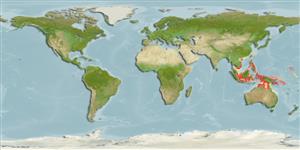>
Acanthuriformes (Surgeonfishes) >
Ephippidae (Spadefishes, batfishes and scats)
Etymology: Rhinoprenes: Greek, rhinos = nose + Greek, prenes = the front part of a body (Ref. 45335).
Environment: milieu / climate zone / depth range / distribution range
Ecologia
marinhas; estuarina demersal. Tropical
Western Pacific: Papua New Guinea to northern Australia.
Tamanho / Peso / Idade
Maturity: Lm ? range ? - ? cm
Max length : 15.0 cm TL macho/indeterminado; (Ref. 245)
Espinhos dorsais (total) : 8; Raios dorsais moles (total) : 19 - 20; Espinhos anais: 3; Raios anais moles: 16 - 17. Body deep and compressed, quadrangular in outline. Mouth small and inferior. Second dorsal spine, fourth pectoral ray, and first pelvic ray greatly prolonged into free filaments which reach tail base or beyond. First dorsal-fin spine, fourth pectoral-fin ray, and first pelvic-fin ray greatly elongated filaments, reaching to or beyond vertical line at rear end of dorsal-and anal-fin bases. Head naked. Mouth inferior, the snout and upper jaw projecting in front of lower jaw (Ref 43039).
Feeds on algae and sewage (Ref. 4537).
Life cycle and mating behavior
Maturidade | Reprodução | Desova | Ovos | Fecundidade | Larvas
Nelson, J.S., 1984. Fishes of the world. 2nd edition. John Wiley & Sons, Inc., New York. 523 p. (Ref. 245)
Categoria na Lista Vermelha da IUCN (Ref. 130435: Version 2024-2)
Ameaça para o homem
Harmless
Utilização humana
Pescarias: sem interesse
Ferramentas
Relatórios especiais
Descarregue XML
Fontes da internet
Estimates based on models
Preferred temperature (Ref.
123201): 26.9 - 28.8, mean 28 °C (based on 232 cells).
Phylogenetic diversity index (Ref.
82804): PD
50 = 1.0000 [Uniqueness, from 0.5 = low to 2.0 = high].
Bayesian length-weight: a=0.02692 (0.01132 - 0.06402), b=2.94 (2.74 - 3.14), in cm total length, based on LWR estimates for this (Sub)family-body shape (Ref.
93245).
Nível Trófico (Ref.
69278): 2.0 ±0.00 se; based on food items.
Resiliência (Ref.
120179): Elevada, tempo mínimo de duplicação da população menor que 15 meses (Preliminary K or Fecundity.).
Fishing Vulnerability (Ref.
59153): Low vulnerability (10 of 100).
